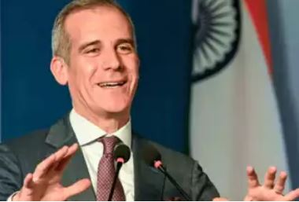America
Garcetti: US Trust in India Enabled Sale of Advanced Jet Engine Technology

July 20 :
The United States has approved selling India its most advanced jet engine technology—technology that the United States has withheld from even its closest allies—to India, according to US Ambassador to India Eric Garcetti, who was highlighting the growing cooperation between India and the United States in the Indo-Pacific region. Bringing up Prime Minister Narendra Modi's trip to the US, the envoy mentioned that the two countries had 173 separate projects, and that even five or ten is a sizable group.
We had 173 separate initiatives going when the prime minister came last year. Some people think that if you can obtain five or 10 on a state visit, that's great. A large group, really. According to Garcetti, there are 173 of them, and he could name 300 or more from the educational ties they have. For example, there are campuses in India and the US that are conducting innovative research on cancer treatments and other diseases.
Garcetti praised the US's confidence in India. He said, "The trust that the United States has for India resulted in the approval of selling our most exquisite jet engine technology, something we haven't even done with some of our closest allies, and the exercises that we are doing to make sure that our people know each other."
During Prime Minister Narendra Modi's historic Official State Visit to the US in June of last year, General Electric and Hindustan Aeronautics inked a memorandum of understanding to co-produce F-414 fighter jet engines in India. The United States Navy has relied on GE's F414 turbofan engine for more than three decades.An innovative high-pressure turbine, a "fueldraulic" system for nozzle area management, a dual-channel full authority digital engine control (FADEC), and a six-stage high-pressure compressor are all part of its equipment.
When called upon, it provides unfettered engine performance, outstanding afterburner light, and lightning-fast throttle response. The F414 engine is a reliable option for contemporary fighter jets, having powered aircraft in eight different nations.
According to the US ambassador, both countries are prepared to work together in an emergency. "We know how to interoperate, whether it's a natural disaster or, God forbid, a war, where we have to be together," added the president. Garcetti referred to the United States and India as "two great democracies," and he stated that the constitution, which protects everyone's civil and human rights, is a part of our democratic system.
"We've certainly been inspired by India's not only an independence movement but the non-violence movement of Mahatma Gandhi and others who helped inform people like Martin Luther King about our struggles for racial equality," according to him. The US envoy made the observation that the US deliberately seeks criticism as part of its foreign strategy.
"So part of our foreign policy is always to invite criticism and also to look at the places we can work together on women's empowerment, the racial and religious minority rights that people have, to be able to practice religion, to be able to not have gender take away from your opportunities and to ensure that all people have equal human rights," said he.
Together, the United States and India are fighting for transgender rights, women's empowerment, the eradication of poverty, and countless other causes, he said. "To me, those are the proactive and positive agenda of human rights between India and the United States, an example that is a contrast to dictatorships and to extremism in the world today," added the president.
The United States envoy went on to say that the biggest solar manufacturing plant in southern India is doing double duty by providing employment opportunities for Indians and supplying high-quality solar power to the United States. This further emphasizes India's cooperation with the US on climate financing. Our efforts on climate financing could be the subject of my speech. Instead of relying on vital minerals that China is limiting, the biggest solar manufacturing factory in southern India is using First Solar to not only generate employment opportunities for Indians but also export these minerals to the United States, ensuring reliable solar power. According to him, that isn't a matter of strategy.
From the ocean floor to the stars, he remarked, the US-India alliance extends. Both the United States and India are powerful positive forces. This is more than a simple exercise in strategy. This is a genuine feeling of togetherness, fueled by our shared belief that our combined strengths would outstrip those of any one nation.































